Shih-Yao Lin
TransFusion: Cross-view Fusion with Transformer for 3D Human Pose Estimation
Oct 29, 2021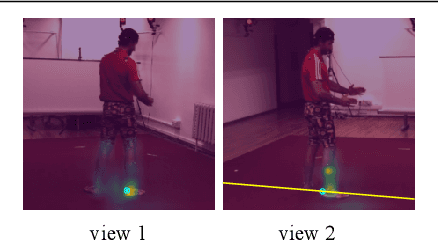



Abstract:Estimating the 2D human poses in each view is typically the first step in calibrated multi-view 3D pose estimation. But the performance of 2D pose detectors suffers from challenging situations such as occlusions and oblique viewing angles. To address these challenges, previous works derive point-to-point correspondences between different views from epipolar geometry and utilize the correspondences to merge prediction heatmaps or feature representations. Instead of post-prediction merge/calibration, here we introduce a transformer framework for multi-view 3D pose estimation, aiming at directly improving individual 2D predictors by integrating information from different views. Inspired by previous multi-modal transformers, we design a unified transformer architecture, named TransFusion, to fuse cues from both current views and neighboring views. Moreover, we propose the concept of epipolar field to encode 3D positional information into the transformer model. The 3D position encoding guided by the epipolar field provides an efficient way of encoding correspondences between pixels of different views. Experiments on Human 3.6M and Ski-Pose show that our method is more efficient and has consistent improvements compared to other fusion methods. Specifically, we achieve 25.8 mm MPJPE on Human 3.6M with only 5M parameters on 256 x 256 resolution.
MVHM: A Large-Scale Multi-View Hand Mesh Benchmark for Accurate 3D Hand Pose Estimation
Dec 06, 2020
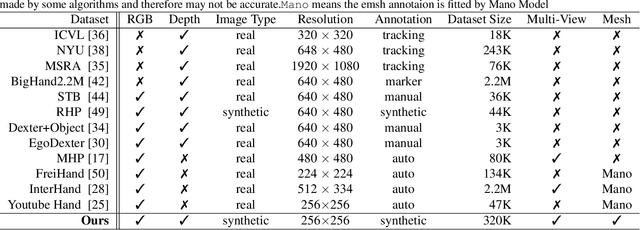

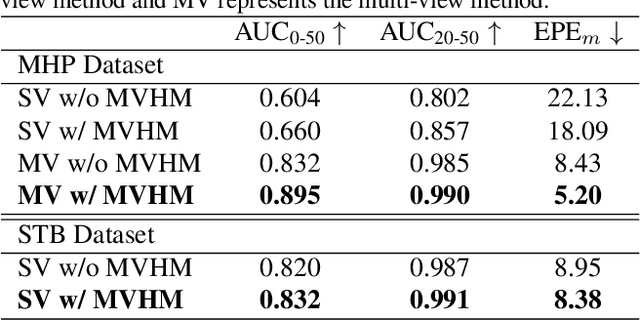
Abstract:Estimating 3D hand poses from a single RGB image is challenging because depth ambiguity leads the problem ill-posed. Training hand pose estimators with 3D hand mesh annotations and multi-view images often results in significant performance gains. However, existing multi-view datasets are relatively small with hand joints annotated by off-the-shelf trackers or automated through model predictions, both of which may be inaccurate and can introduce biases. Collecting a large-scale multi-view 3D hand pose images with accurate mesh and joint annotations is valuable but strenuous. In this paper, we design a spin match algorithm that enables a rigid mesh model matching with any target mesh ground truth. Based on the match algorithm, we propose an efficient pipeline to generate a large-scale multi-view hand mesh (MVHM) dataset with accurate 3D hand mesh and joint labels. We further present a multi-view hand pose estimation approach to verify that training a hand pose estimator with our generated dataset greatly enhances the performance. Experimental results show that our approach achieves the performance of 0.990 in $\text{AUC}_{\text{20-50}}$ on the MHP dataset compared to the previous state-of-the-art of 0.939 on this dataset. Our datasset is public available. \footnote{\url{https://github.com/Kuzphi/MVHM}} Our datasset is available at~\href{https://github.com/Kuzphi/MVHM}{\color{blue}{https://github.com/Kuzphi/MVHM}}.
Temporal-Aware Self-Supervised Learning for 3D Hand Pose and Mesh Estimation in Videos
Dec 06, 2020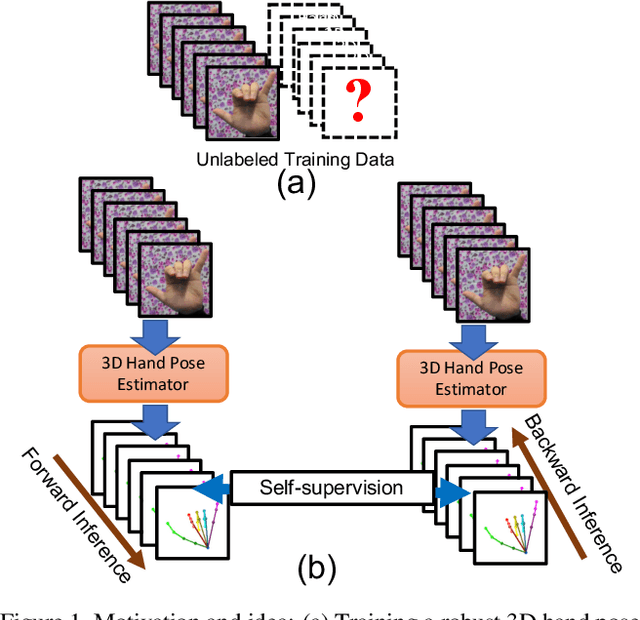


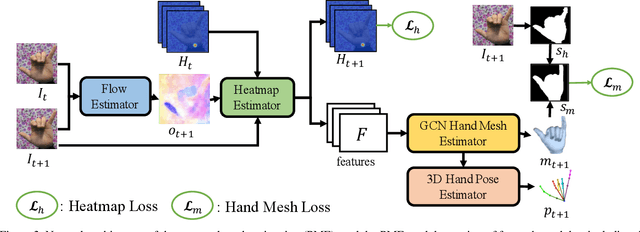
Abstract:Estimating 3D hand pose directly from RGB imagesis challenging but has gained steady progress recently bytraining deep models with annotated 3D poses. Howeverannotating 3D poses is difficult and as such only a few 3Dhand pose datasets are available, all with limited samplesizes. In this study, we propose a new framework of training3D pose estimation models from RGB images without usingexplicit 3D annotations, i.e., trained with only 2D informa-tion. Our framework is motivated by two observations: 1)Videos provide richer information for estimating 3D posesas opposed to static images; 2) Estimated 3D poses oughtto be consistent whether the videos are viewed in the for-ward order or reverse order. We leverage these two obser-vations to develop a self-supervised learning model calledtemporal-aware self-supervised network (TASSN). By en-forcing temporal consistency constraints, TASSN learns 3Dhand poses and meshes from videos with only 2D keypointposition annotations. Experiments show that our modelachieves surprisingly good results, with 3D estimation ac-curacy on par with the state-of-the-art models trained with3D annotations, highlighting the benefit of the temporalconsistency in constraining 3D prediction models.
DGGAN: Depth-image Guided Generative Adversarial Networks for Disentangling RGB and Depth Images in 3D Hand Pose Estimation
Dec 06, 2020



Abstract:Estimating3D hand poses from RGB images is essentialto a wide range of potential applications, but is challengingowing to substantial ambiguity in the inference of depth in-formation from RGB images. State-of-the-art estimators ad-dress this problem by regularizing3D hand pose estimationmodels during training to enforce the consistency betweenthe predicted3D poses and the ground-truth depth maps.However, these estimators rely on both RGB images and thepaired depth maps during training. In this study, we proposea conditional generative adversarial network (GAN) model,called Depth-image Guided GAN (DGGAN), to generate re-alistic depth maps conditioned on the input RGB image, anduse the synthesized depth maps to regularize the3D handpose estimation model, therefore eliminating the need forground-truth depth maps. Experimental results on multiplebenchmark datasets show that the synthesized depth mapsproduced by DGGAN are quite effective in regularizing thepose estimation model, yielding new state-of-the-art resultsin estimation accuracy, notably reducing the mean3D end-point errors (EPE) by4.7%,16.5%, and6.8%on the RHD,STB and MHP datasets, respectively.
MM-Hand: 3D-Aware Multi-Modal Guided Hand Generative Network for 3D Hand Pose Synthesis
Oct 02, 2020


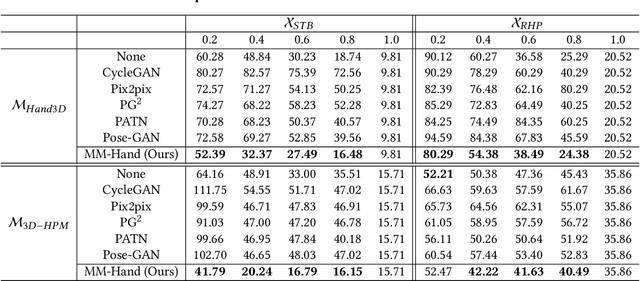
Abstract:Estimating the 3D hand pose from a monocular RGB image is important but challenging. A solution is training on large-scale RGB hand images with accurate 3D hand keypoint annotations. However, it is too expensive in practice. Instead, we have developed a learning-based approach to synthesize realistic, diverse, and 3D pose-preserving hand images under the guidance of 3D pose information. We propose a 3D-aware multi-modal guided hand generative network (MM-Hand), together with a novel geometry-based curriculum learning strategy. Our extensive experimental results demonstrate that the 3D-annotated images generated by MM-Hand qualitatively and quantitatively outperform existing options. Moreover, the augmented data can consistently improve the quantitative performance of the state-of-the-art 3D hand pose estimators on two benchmark datasets. The code will be available at https://github.com/ScottHoang/mm-hand.
Learning Conditional Random Fields with Augmented Observations for Partially Observed Action Recognition
Dec 05, 2018

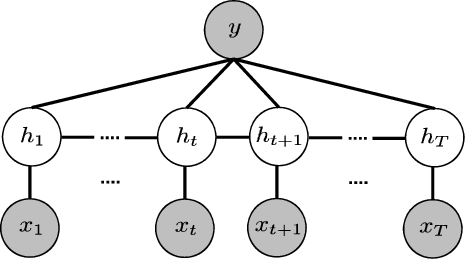

Abstract:This paper aims at recognizing partially observed human actions in videos. Action videos acquired in uncontrolled environments often contain corrupt frames, which make actions partially observed. Furthermore, these frames can last for arbitrary lengths of time and appear irregularly. They are inconsistent with training data and degrade the performance of pre-trained action recognition systems. We present an approach to address this issue. For each training and testing actions, we divide it into segments and explore the mutual dependency between temporal segments. This property states that the similarity of two actions at one segment often implies their similarity at another. We augment each segment with extra alternatives retrieved from training data. The augmentation algorithm is designed in a way where a few alternatives are good enough to replace the original segment where corrupt frames occur. Our approach is developed upon hidden conditional random fields and leverages the flexibility of hidden variables for uncertainty handling. It turns out that our approach integrates corrupt segment detection and alternative selection into the process of prediction, and can recognize partially observed actions more accurately. It is evaluated on both fully observed actions and partially observed ones with either synthetic or real corrupt frames. The experimental results manifest its general applicability and superior performance, especially when corrupt frames are present in the action videos.
Generating Realistic Training Images Based on Tonality-Alignment Generative Adversarial Networks for Hand Pose Estimation
Nov 27, 2018



Abstract:Hand pose estimation from a monocular RGB image is an important but challenging task. The main factor affecting its performance is the lack of a sufficiently large training dataset with accurate hand-keypoint annotations. In this work, we circumvent this problem by proposing an effective method for generating realistic hand poses and show that state-of-the-art algorithms for hand pose estimation can be greatly improved by utilizing the generated hand poses as training data. Specifically, we first adopt an augmented reality (AR) simulator to synthesize hand poses with accurate hand-keypoint labels. Although the synthetic hand poses come with precise joint labels, eliminating the need of manual annotations, they look unnatural and are not the ideal training data. To produce more realistic hand poses, we propose to blend a synthetic hand pose with a real background, such as arms and sleeves. To this end, we develop tonality-alignment generative adversarial networks (TAGANs), which align the tonality and color distributions between synthetic hand poses and real backgrounds, and can generate high quality hand poses. We evaluate TAGAN on three benchmarks, including the RHP, STB, and CMU-PS hand pose datasets. With the aid of the synthesized poses, our method performs favorably against the state-of-the-arts in both $2$D and $3$D hand pose estimations.
 Add to Chrome
Add to Chrome Add to Firefox
Add to Firefox Add to Edge
Add to Edge